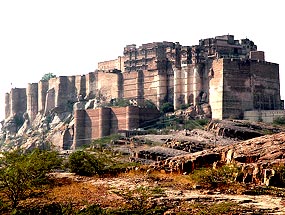Mehrangarh Fort of Jodhpur is regarded as one of
the largest forts in India. Know more about Mehrangarh Fort of
Rajasthan with this article.
Mehrangarh Fort

Location: Jodhpur, Rajasthan
Founded By: Rao Jodha
Founded In: 1459
Mehrangarh Fort of Jodhpur is the most impressive as well as the
biggest fort of Rajasthan. Infact, the fort is famous for being one of
the largest forts in the whole of India. One of the most popular tourist
destinations of Rajasthan, Mehrangarh Fort is perched at a height of
approximately 400 feet above the city. It is bounded by imposing thick
walls and comprises of a number of structures inside its complex,
including several palaces with sprawling courtyards. The fort was built
under the patronage of Rao Jodha, the fifteenth Rathore ruler.
Rao Jodha acceded the throne in the year 1458 and one year after his
accession, laid down the foundation of the Mehrangarh Fort. The main
reason for the establishment of the fort was that Mandore fort was no
longer considered as secure and there was a need to move to a safer
place. There is a very interesting story behind the establishment of the
Mehrangarh Fort. The construction work for the fort was started on a
hill, known as Bhaurcheeria, the mountain of birds. At that time, it was
occupied by a hermit, known as Cheeria Nathji, the lord of birds.
To build the fort, Cheeria Nathji was forced to leave his cave. Angered
by this act, the hermit cursed Rao Jodha, saying that his citadel will
suffer from the scarcity of water. To escape the effects of the curse,
Jodha built a house and a temple in the fort, near the hermit's cave, to
appease God. Jodha then took the extreme step to ensure the prosperity
of his fort. He buried a man alive in its foundations, by promising to
look after his family throughout their life. Today, Mehrangarh Fort
boasts of being the pride of Jodhpur.
The walls of the fort rise to a height of 36 m, with their width being
approximately 21 m. There are three magnificent gates inside the fort
complex, each constructed to commemorate some victory. The numerous
palaces situated inside the fort are adorned with exceptional
decorations. The most exquisite amongst these are Moti Mahal (Pearl
Palace), Phool Mahal (Flower Palace), Sheesh Mahal (Mirror Palace),
Sileh Khana and Daulat Khana. Mehrangarh Fort also houses a rich
collection of artifacts.
Main Attractions
Chamunda Mataji Temple
Chamunda Mataji Temple was built by Rao Jodha, who brought the main
idol from the old capital of Mandore in 1460. The temple sees
exceptionally large crowd during Dussehra celebrations.
Period Rooms
There are a number of period rooms inside the Mehrangarh Fort.
Moti Mahal
Moti Mahal is the largest period room of the fort. Raja Sur Singh built
the palace, which has five alcoves leading onto hidden balconies. It is
believed that these balconies were intended to be used by his five
queens, for listening in on the court proceeding.
Sheesh Mahal
Sheesh Mahal has been as per the typical Rajput architectural style.
The palace is adorned with exquisite mirror work, an intricate mosaic of
tiny fragments. The work has been superimposed over painted religious
figures of plaster.
Phool Mahal
Phool Mahal, built by Maharaja Abhaya Singh, is the most splendid
period room of Mehrangarh. It was intended to be used as a chamber of
pleasure. Here, the Maharajas used to watch girls dancing under a
ceiling of gold filigree.
Takhat Vilas
Takhat Vilas served as the residence of Maharaja Takhat Singh, the last
ruler to stay in the Mehrangarh Fort. The ceiling of the palace has been
adorned with splendid glass balls.
Galleries
The several galleries of Mehrangarh fort are definitely worth a visit.
Howdah Gallery
Howdah is the name given to the two-compartment wooden seat tied to the
back of an elephant. The front compartment is large and has a raised
protective metal sheet, while the rear one is small. The front one was
meant for the kings or royalty and the rear one was for the bodyguards.
One can still see some howdahs of that period in the gallery.
Palanquin Gallery
Palanquins were used as a means of travel by the ladies of the royalty,
till the second quarter of the 20th century. Numerous decorated
palanquins can be seen in this gallery.
Daulat Khana
The Daulat Khana houses a rich collection of fine and applied arts of
the Mughal period.
Armory
The gallery that used to serve as the Armory exhibits an assortment of
rare weapons, dating back to every period in Jodhpur. The display
includes sword hilts in jade, silver, rhine horn, ivory, shields studded
with rubies, emeralds and pearls, guns with gold and silver work on
barrels, personal swords of emperors, etc. Then, there is the Khanda of
Rao Jodha, which weighs over 7 pounds, along with the swords of Akbar
and Timur.
Painting Gallery
The painting gallery houses a rich compilation of Marwar paintings.
Turban Gallery
Turban Gallery displays different types of turbans that used to be worn
by the people of Rajasthan in the past.
Folk Musical Instruments Gallery
This gallery houses various types of folk musical instruments, some of
them characteristic of a particular group or community and some, of a
particular region.


